 You may remember my post from July 21, Renovation Part II, a discussion of what finishing touches were yet to come in this project. If you missed that, I will recap. This beautiful Mediterranean house was in need of a landscape renovation; the new owner is a designer herself, and what she had, she knew would not do.
You may remember my post from July 21, Renovation Part II, a discussion of what finishing touches were yet to come in this project. If you missed that, I will recap. This beautiful Mediterranean house was in need of a landscape renovation; the new owner is a designer herself, and what she had, she knew would not do.

I did like the U-shape of brick here, although it seemed too small, and had been installed without attending to the grade issues first. That idea was the one thing worth saving.
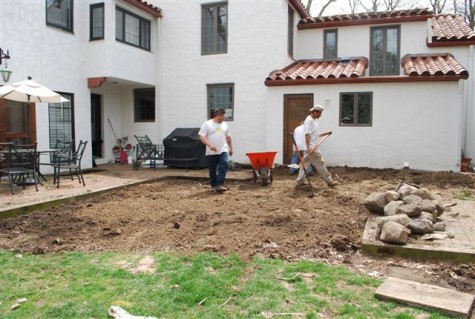 We removed all the plants, and brick, and graded out to the edge of the house; it is too awkward to step down in the middle of a terrace. In other words, we started over.
We removed all the plants, and brick, and graded out to the edge of the house; it is too awkward to step down in the middle of a terrace. In other words, we started over.
 The new and larger granite and brick terrace stepped down into the lawn; a new stucco wall made for extra seating for guests, and made the suggestion of enclosure.
The new and larger granite and brick terrace stepped down into the lawn; a new stucco wall made for extra seating for guests, and made the suggestion of enclosure.
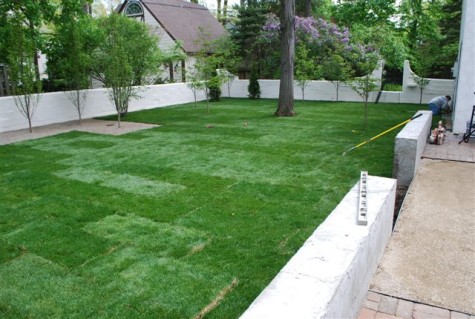 The new rear yard landscape made much of the repaired and repainted stucco wall . A grove of trees in the lawn, a formal arrangement of trees mulched in granite, and grass. Simple and striking.
The new rear yard landscape made much of the repaired and repainted stucco wall . A grove of trees in the lawn, a formal arrangement of trees mulched in granite, and grass. Simple and striking.
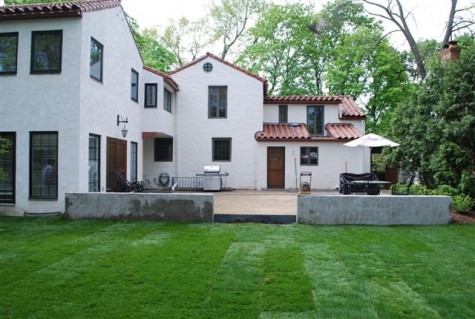 But what else did this landscape need in the way of finishing touches? Inspired by the Spanish flavor of the architecture, I thought some ironwork might be in order.
But what else did this landscape need in the way of finishing touches? Inspired by the Spanish flavor of the architecture, I thought some ironwork might be in order.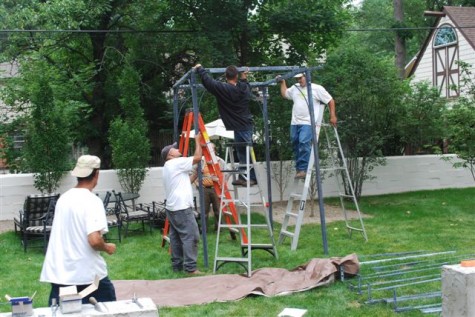
One iron pergola would have been a little overpowering. Two smaller matching iron pergolas, which would eventually support grape vines, seemed like a great way to warm up the space, and give that terrace a more room-like feeling.
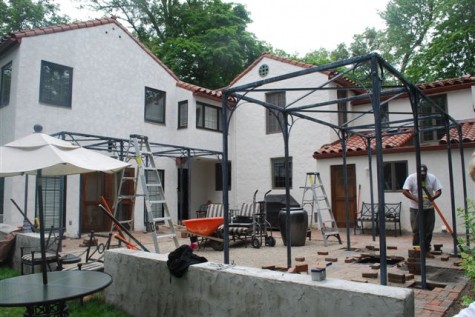 I especially like how the terrace will have two shady cool areas, with a sunny space in between them.
I especially like how the terrace will have two shady cool areas, with a sunny space in between them.
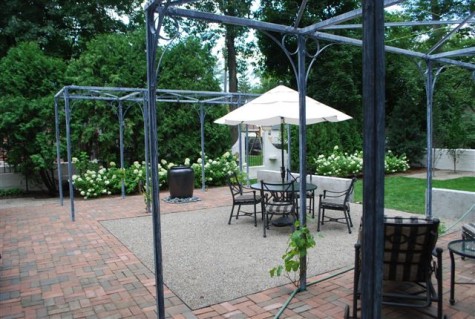 Finishing touches like this can make all the difference in the world; this space looks inviting and comfortable. A place to have dinner, a place to read in the shade, a place to entertain-all good things to plan for.
Finishing touches like this can make all the difference in the world; this space looks inviting and comfortable. A place to have dinner, a place to read in the shade, a place to entertain-all good things to plan for.
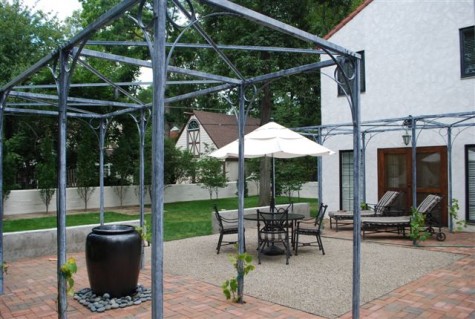 The last touch – a self-contained fountain jar. The reservoir to recirculate the water was installed underground. My client opted for a water jet barely visible. Lighting was unobtrusively installed in the pergola roof, illuminating the fountain at night. I can imagine how it will look and sound once there are grapes overhead.
The last touch – a self-contained fountain jar. The reservoir to recirculate the water was installed underground. My client opted for a water jet barely visible. Lighting was unobtrusively installed in the pergola roof, illuminating the fountain at night. I can imagine how it will look and sound once there are grapes overhead.
 A new umbrella is on the way. Maybe there will be holiday lights this winter. Maybe next summer there will be some pots. The finishing touches phase transforms the designed landscape into a landscape for living.
A new umbrella is on the way. Maybe there will be holiday lights this winter. Maybe next summer there will be some pots. The finishing touches phase transforms the designed landscape into a landscape for living.
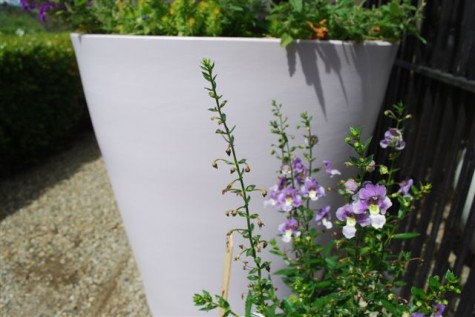
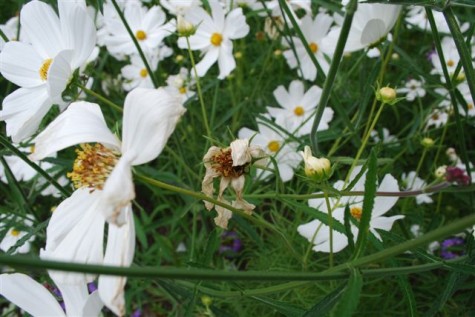
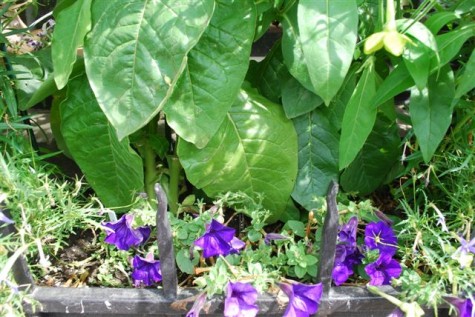 Plants grow in, and the room can get crowded. If the giant leaves of this nicotiana are allowed to shade the petunia, said petunia will pout, and finally give up. Removing leaves, or branches so everyone has a sunny spot, is good group management. A pot or window box is no place for a bully running amok. No one will like the result- least of all, you.
Plants grow in, and the room can get crowded. If the giant leaves of this nicotiana are allowed to shade the petunia, said petunia will pout, and finally give up. Removing leaves, or branches so everyone has a sunny spot, is good group management. A pot or window box is no place for a bully running amok. No one will like the result- least of all, you.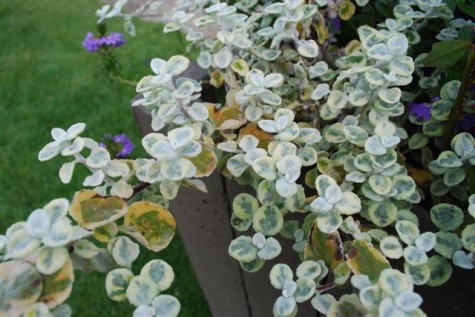 Try not to overwater. Put your finger down into the dirt. If the dirt sticks to you, there is probably enough moisture. Rotting leaves are unsightly. Worse yet, an environment that is too wet is an invitation to every fungus floating by, looking for a good home. Licorice likes dry conditions. Should you have been so bold to plant it next to an annual that loves water and more water, you’ve engineered a situation where individual plants in a community pot have to be watered on different schedules. This is not tough, just time-consuming.
Try not to overwater. Put your finger down into the dirt. If the dirt sticks to you, there is probably enough moisture. Rotting leaves are unsightly. Worse yet, an environment that is too wet is an invitation to every fungus floating by, looking for a good home. Licorice likes dry conditions. Should you have been so bold to plant it next to an annual that loves water and more water, you’ve engineered a situation where individual plants in a community pot have to be watered on different schedules. This is not tough, just time-consuming. Annuals need pruning, just like shrubs and trees. Pruning the flowers from your coleus plants result in densely growing coleus. Pruning plants at different heights gives everyone breathing room. Once a group of plants are put together in one pot, or one area, they take on a collective life. Sun, water and space have to be shared. And whatever the individual plants, you want an overall shape that looks great.
Annuals need pruning, just like shrubs and trees. Pruning the flowers from your coleus plants result in densely growing coleus. Pruning plants at different heights gives everyone breathing room. Once a group of plants are put together in one pot, or one area, they take on a collective life. Sun, water and space have to be shared. And whatever the individual plants, you want an overall shape that looks great. 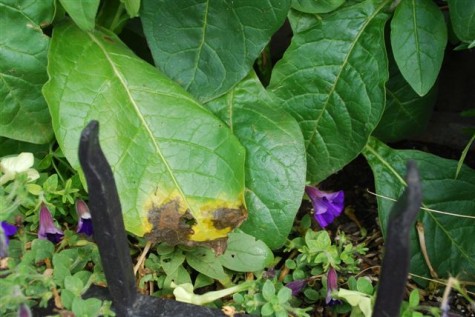
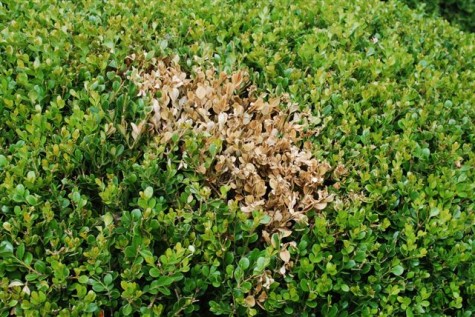 My beloved boxwood hedge was attacked this spring by a fungus called Volutella-I was beside myself over the damage. I had to get an expert to identify it for me; I have never seen this on boxwood before. We cleaned out, and raked up every dead leaf, and pruned out every infected branch with shears that were disinfected after each cut. Next spring I will spray for it. Imagine being a greenhouse grower-where plant illnesses and insects can threaten a livlihood. Most growers that I know practice close inspection of their plants, so they catch problems early. They also feed their plants; strong plants resist trouble. Once every seven to ten days I make sure my pots are thoroughly watered, then I liquid- feed them with a water soluble fertilizer with a big middle number (15-30-15) to encourage good flower production. This acts like a shot of vitamin B-12. Then I hold off watering as long as I can, so the plants take up the nutrients, before they get flushed out by the next round of watering.
My beloved boxwood hedge was attacked this spring by a fungus called Volutella-I was beside myself over the damage. I had to get an expert to identify it for me; I have never seen this on boxwood before. We cleaned out, and raked up every dead leaf, and pruned out every infected branch with shears that were disinfected after each cut. Next spring I will spray for it. Imagine being a greenhouse grower-where plant illnesses and insects can threaten a livlihood. Most growers that I know practice close inspection of their plants, so they catch problems early. They also feed their plants; strong plants resist trouble. Once every seven to ten days I make sure my pots are thoroughly watered, then I liquid- feed them with a water soluble fertilizer with a big middle number (15-30-15) to encourage good flower production. This acts like a shot of vitamin B-12. Then I hold off watering as long as I can, so the plants take up the nutrients, before they get flushed out by the next round of watering.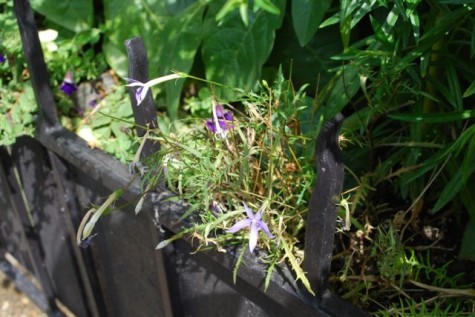
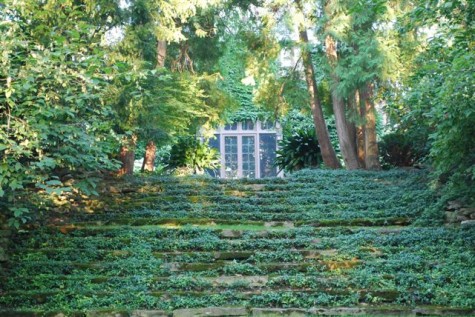 This very old, very lovely, wide flight of stairs was once buried in soil and debris; only the center four feet was still visible and useable. I discovered it by accident, while trying to plant trees and groundcover on either side. Once I explained to my client that another twelve feet of staircase still existed just below the surface, she had me uncover it entirely. We planted the risers with myrtle. This staircase is much more about ornament and architecture, than about going from one level to another. As the lower garden is viewed primarily from the house above, the beauty of these steps is more important than the issue of how to get from here to there.
This very old, very lovely, wide flight of stairs was once buried in soil and debris; only the center four feet was still visible and useable. I discovered it by accident, while trying to plant trees and groundcover on either side. Once I explained to my client that another twelve feet of staircase still existed just below the surface, she had me uncover it entirely. We planted the risers with myrtle. This staircase is much more about ornament and architecture, than about going from one level to another. As the lower garden is viewed primarily from the house above, the beauty of these steps is more important than the issue of how to get from here to there.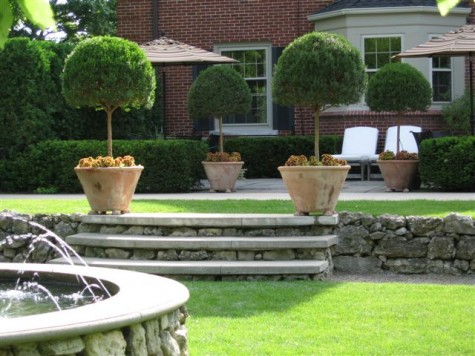 The change of level in a landscape can create interest, announce a new garden room-change things up. This previously sloped garden space was excavated and walled with the stone that had been used to edge the original beds. The steps now necessary to descend to the lower level signal the transition. The treads are shallow, so as not to intrude on the rectangle of grass below. A good height for a step is 7 inches; 8 inches will work, but is just slightly on the steep side. Every step in a flight of stairs needs to be the same height; people instinctively assume this. Note how the gravel in front of the wall, dying into the lower step, makes the maintenance of the lawn plane simple.
The change of level in a landscape can create interest, announce a new garden room-change things up. This previously sloped garden space was excavated and walled with the stone that had been used to edge the original beds. The steps now necessary to descend to the lower level signal the transition. The treads are shallow, so as not to intrude on the rectangle of grass below. A good height for a step is 7 inches; 8 inches will work, but is just slightly on the steep side. Every step in a flight of stairs needs to be the same height; people instinctively assume this. Note how the gravel in front of the wall, dying into the lower step, makes the maintenance of the lawn plane simple.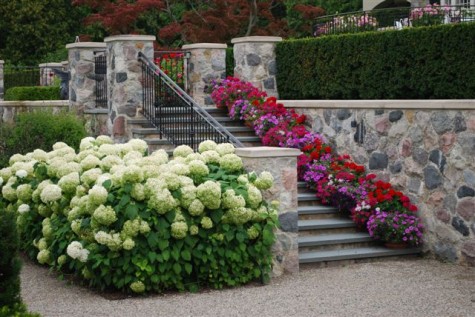 Some changes of level are dramatic, and require a flight of steps, and railings. Any stairs need to be designed first and foremost to allow for safe passage. Each of these steps is marked with its own pot of flowers. The iron railing is as sturdy as it is beautiful. Iron rails allow a garden to remain open to view while providing some security.
Some changes of level are dramatic, and require a flight of steps, and railings. Any stairs need to be designed first and foremost to allow for safe passage. Each of these steps is marked with its own pot of flowers. The iron railing is as sturdy as it is beautiful. Iron rails allow a garden to remain open to view while providing some security. Splitting up steps can be even more friendly to guests. It is far easier to negotiate one or two steps at a time, with a landing in place prior to the next set of steps. These stairs are wider that the door and side windows; this makes for a generous and welcoming approach.
Splitting up steps can be even more friendly to guests. It is far easier to negotiate one or two steps at a time, with a landing in place prior to the next set of steps. These stairs are wider that the door and side windows; this makes for a generous and welcoming approach. This winding staircase seems to spill out of the confluence of two walls designed and built on the bias. The variation in stair width creates a sense of motion and rhythm which is very pleasing. The wall enclosure makes it possible to climb these stairs with confidence.
This winding staircase seems to spill out of the confluence of two walls designed and built on the bias. The variation in stair width creates a sense of motion and rhythm which is very pleasing. The wall enclosure makes it possible to climb these stairs with confidence.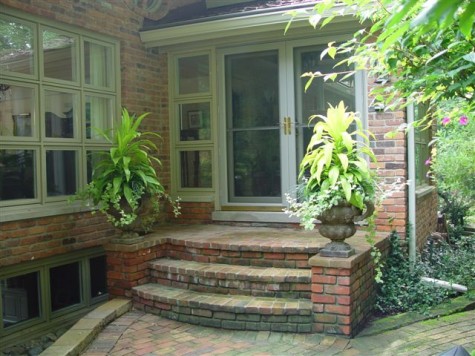 Stairs can vary in their depth. The first stair out of this front door functions as a landing-a comfortable space for greetings, and goodbys. The brick piers and pots are a succesful alternative to railings, which would have seemed so heavy handed here.
Stairs can vary in their depth. The first stair out of this front door functions as a landing-a comfortable space for greetings, and goodbys. The brick piers and pots are a succesful alternative to railings, which would have seemed so heavy handed here. Natural stone frequently has a uneven surface. Planning for a safe ascent and descent is doubly important. The iron fence walls inset from the stairs provide an emergency handhold for anyone loosing their footing.
Natural stone frequently has a uneven surface. Planning for a safe ascent and descent is doubly important. The iron fence walls inset from the stairs provide an emergency handhold for anyone loosing their footing. 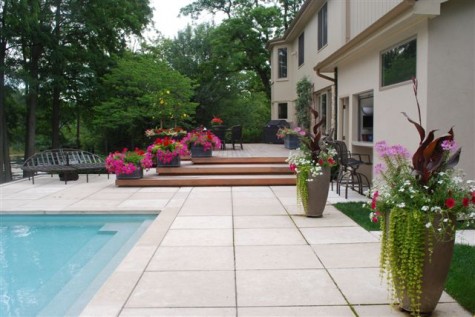 These wood stairs to the upper terrace are very spacious in every dimension. Steps with greater depth are easier to negotiate. Steps to a rear terrace are frequently used while carrying food and drink; it is better to err on the side of too deep, than too shallow. The pots announce the change of level for anyone concentrating more on keeping their tray of food where it belongs, , than watching where they step.
These wood stairs to the upper terrace are very spacious in every dimension. Steps with greater depth are easier to negotiate. Steps to a rear terrace are frequently used while carrying food and drink; it is better to err on the side of too deep, than too shallow. The pots announce the change of level for anyone concentrating more on keeping their tray of food where it belongs, , than watching where they step.